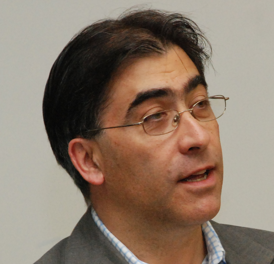Dr. Alexander Kalloniatis
Defence Science & Technology Group (Australia)

Abstract:
Over many years I have been developing an approach to modelling dynamic networked C2 systems using the framework of the famous Kuramoto model for synchronisation. This model takes phase oscillators coupled on a network of arbitrary structure and enables testing of the ability of the oscillators to synchronise through mutual interaction depending on topology, coupling strength and distribution of native frequencies. In C2 applications, the oscillator phase represents a continuous Observe-Orient-Decide-Act loop. Human properties of decision-making – such as heterogeneity and aggressiveness or caution in coming to decisions may be represented through various stochastic additions to the basic model. The framework of the model is general enough that it may represent both human information artefacts and artificial agents, such as AI-based `bots’. The model, being expressed through coupled differential equations, is therefore executable – allowing predictive modelling of C2 improvement or intervention strategies. Recently, I applied this model to operational data based on Australian Defence Force C2 elements in order to conduct a first-cut validation of the model. In this talk I will retrace this validation, and then demonstrate an adaptive control mechanism that enables the degree of synchronisation to be improved, as well as control of the system to different collective speeds of decision-making.
Speaker Information:
Dr. Alexander Kalloniatis joined what was then called `DSTO’ in 2005 after an academic career in theoretical particle physics (PhD from Adelaide in 1992, postdocs in Germany, ARC Fellowship back in Adelaide). He has been involved with various aspects of analysis of C2 arrangements and processes in Australian operational level joint HQs – including modelling and simulation of the J5 planning process, the interaction between Battle-Rhythm and Crisis management in J3, fatigue modelling in of watch staff, and the network of information flows between J2 and J3 in the building of situation awareness. Since 2014 Alex has been on a 3 year CDS fellowship, developing a mathematical model of synchronisation on networks as a representation of C2. He has published in a wide range of high quality specialist journals including Physica D, Physical Review E, Applied Ergonomics and the International C2 Journal.
Date/Time
06/14/2017
1:30 pm - 2:30 pm
Location
C4I Center ENGR 4705
